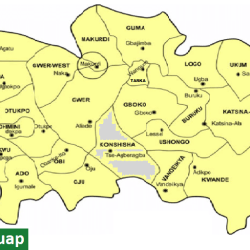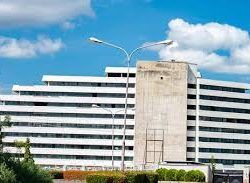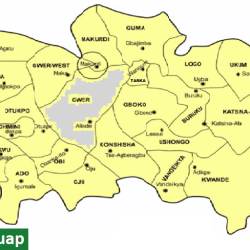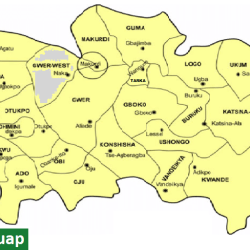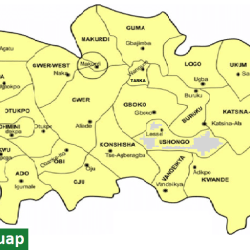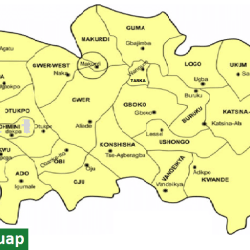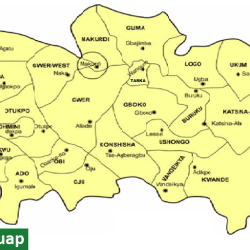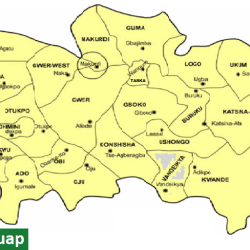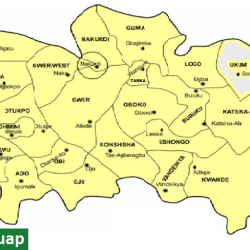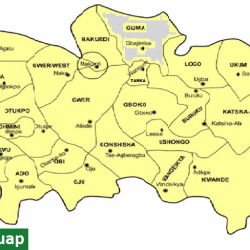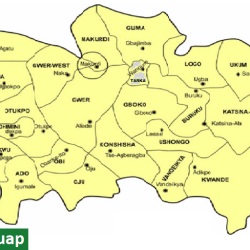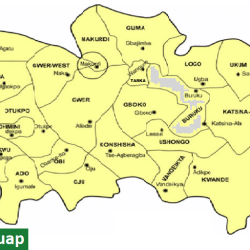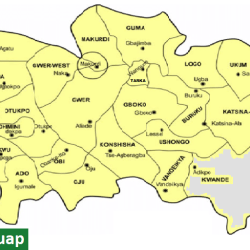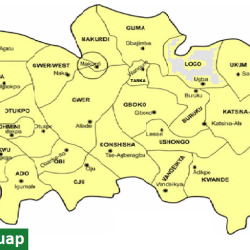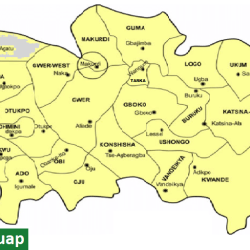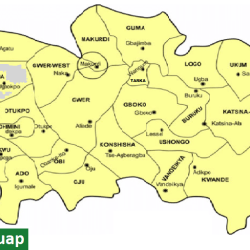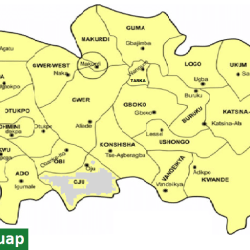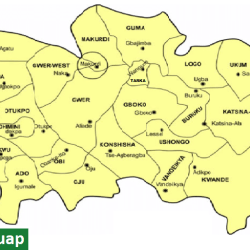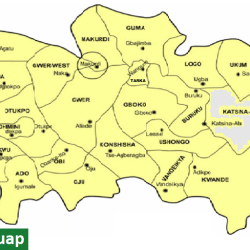The 23 Local Government Areas in Benue State are:
- Ado
- Agatu
- Apa
- Buruku
- Gboko
- Guma
- Gwer East
- Gwer West
- Katsina-Ala
- Konshisha
- Kwande
- Logo
- Makurdi
- Obi
- Ogbadibo
- Oju
- Okpokwu
- Ohimini
- Oturkpo
- Tarka
- Ukum
- Ushongo
- Vandeikya
LGA | Headquarters |
| Ado | Igumale |
| Agatu | Obagaji |
| Apa | Ugbokpo |
| Buruku | Buruku |
| Gboko | Gboko |
| Guma | Gbajimba |
| Gwer East | Aliade |
| Gwer West | Naka |
| Katsina-Ala | Katsina-Ala |
| Konshisha | Tse-Agberagba |
| Kwande | Adikpo |
| Logo | Ugba |
| Makurdi | Makurdi |
| Obi | Obarike-Ito |
| Ogbadibo | Otukpa |
| Ohimini | Idekpa |
| Oju | Oju |
| Okpokwu | Okpoga |
| Otukpo | Otukpo |
| Tarka | Wannune |
| Ukum | Sankera |
| Ushongo | Lessel |
| Vandeikya | Vandeikya |
Benue State, located in the North-Central geopolitical zone of Nigeria, is known as the “Food Basket of the Nation” due to its rich agricultural resources. Established in 1976, the state has gained prominence for its fertile lands, vast river systems, and a vibrant cultural heritage, especially among the Tiv and Idoma ethnic groups
The state was created on February 3, 1976. It was one of the seven new states created by the military administration headed by the late General Murtala Muhammed, which increased the number of states in the federation from twelve to nineteen.
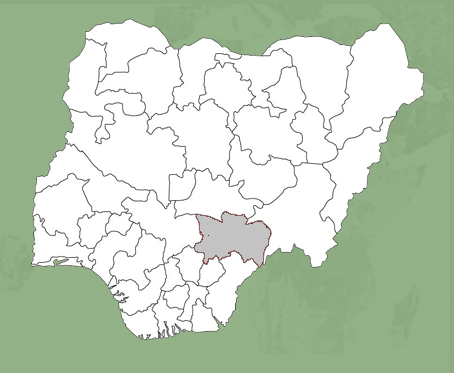
The state derived its name from the River Benue which is the second largest river in the country and the most outstanding geographic feature in the state.At creation, the state comprised of three local governments in the Tiv-speaking areas, namely Gboko, Katsina-Ala, and Makurdi; one local government (Otukpo) in the Idoma-speaking areas and three local governments (Ankpa, Idah and Dekina) in the Igala-speaking areas, which were excised from Kwara state.
Local Government Areas in Benue
Benue State has 23 LGAs, each with unique geographic, economic, and cultural attributes. These LGAs are essential for the administration of rural and urban areas, with each contributing to the overall development of the state. The LGAs also reflect the state’s ethnic diversity, with many of them representing specific cultural groups.
5. Ado
Ado LGA is located in the southern part of Benue State and is predominantly inhabited by the Idoma people. The area is known for its agricultural activities, with major crops including yam, cassava, maize, and groundnuts. The town of Igumale serves as the headquarters of Ado LGA. Ado also has cultural festivals that celebrate the Idoma heritage, attracting tourists and cultural enthusiasts.
Key town: Igumale
6. Agatu
Agatu LGA is located in the central part of Benue State and is primarily an agricultural area. It is known for producing rice, maize, yam, and cassava. The LGA is situated along the banks of the River Benue, providing opportunities for fishing and water transport. Agatu is also significant for its cultural heritage, with various festivals held throughout the year.
Key industries: Agriculture, fishing.
7. Apa
Apa LGA is located in the Idoma-speaking region of Benue State. The LGA has a rich agricultural economy, with fishing being an important economic activity due to its location near the River Benue. In addition to farming, the area is known for its historical and cultural significance, with several traditional festivals held to celebrate Idoma traditions.
8. Buruku
Buruku LGA is situated in the central part of Benue State and is largely an agricultural community. The area’s fertile land supports the cultivation of a wide variety of crops, including yam, cassava, and rice. The River Buruku runs through the LGA, providing water resources for irrigation and fishing. Buruku is also known for its cultural festivals, which attract people from surrounding areas.
Key economic activities: Agriculture, fishing.
9. Gboko
Gboko LGA is one of the most prominent areas in Benue State, primarily due to its status as the cultural center of the Tiv people. Gboko serves as an important commercial and educational hub, with several institutions located within the LGA. The town of Gboko, the LGA’s administrative center, hosts various cultural and traditional events, making it a focal point for Tiv identity. The economy is diverse, ranging from agriculture to small-scale industries.
Key town: Gboko
10. Guma
Guma LGA is located in the northern part of Benue State, with its headquarters in Gbajimba. It is an agricultural area known for producing crops such as maize, millet, groundnuts, and cassava. The LGA plays a significant role in supplying food to surrounding areas. Guma is also culturally important, as it is home to several Tiv traditions and festivals.
Key industries: Agriculture, local trading.
11. Gwer East
Gwer East LGA is an agricultural region known for producing food crops such as yam, maize, and rice. The LGA is home to several rural communities that depend on farming as their primary source of livelihood. The area also hosts cultural festivals, which celebrate the rich heritage of the Tiv people.
Key town: Aliade
12. Gwer West
Gwer West LGA is another agriculturally rich area within Benue State. The LGA is known for its production of yams, which are widely consumed across Nigeria. It also produces other food crops and plays a key role in the state’s food production capacity. Gwer West is home to various Tiv cultural celebrations, which draw visitors from neighboring LGAs.
Key towns: Naka, Agagbe.
13. Katsina-Ala
Katsina-Ala LGA is located along the banks of the Katsina-Ala River, which is an important economic and transportation hub. The LGA is famous for its agricultural output, particularly in yam, rice, and cassava production. Katsina-Ala town, the administrative center, is a historic place with deep cultural significance, serving as a trading center for agricultural goods.
Key town: Katsina-Ala, Abaji.
